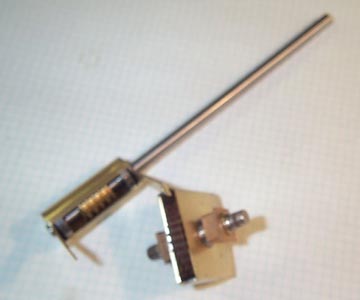Page Originated 8/1997
Page Updated 06/13/2022
Last update:
MAKING YOUR LOCOS LOOK AND
RUN THE WAY YOU WANT
ROD MILLER'S DRIVE SYSTEMS
Locomotives That Work As Well As They Look
Turn That Roundhouse Queen Into The King Of The Road
[sorry]
This page describes how to service the drives that Jerry White and I have built
over the years. The general practices described below may be applicable to other drive
systems but your applying these practices to other systems is at your own risk.
Servicing the drives is straight forward. Servicing is defined as lubricating the motor,
the gearbox, on steam locos
the drive wheels and associated moving parts, and on all locos the axle journals on trucks.
The same process applies to drives that
were built by Jerry White and by me with one change - see below.
When to service the drive is driven by how many hours the locomotive has been run since its
last servicing. Locos that are run in exibilition use (run continuouisly for many hours
on a daily basis) should be serviced once a year. Locos that are run in normal model
railroad use (a few hours a week) should be serviced every five years. If you have bought
a model with one of these drives and don't when know when it was last serviced it would be a good
idea to service it before running continuously. As always your own good judgement is the best guide.
- Tools
- You will need lubricants, a dispenser for oil drops and a hypodermic syringe for injecting gear oil into
the gearbox. The dispenser and syringe are available from me - the syringe is preloaded with
Molycote BR2 which is what the gearboxes were lubricated with when new. Oil is available on
your motor vehicle's dipstick.
If you want to use your own tools, the maximum size for the needle on the hypodermic
syringe that will fit the hole
in the gearbox is 18 (tubing) gauge - be careful of sharp needles! Generic terms for searching are
"hypodermic dispenser needles" and "Needle Oiler".
You may be able to find what you need at a hobby shop, an auto parts store or
scientific supply stores.
- Motors
- Most but not all brives built by me and Jerry White will have
a Pittman motor. These motors will have ball bearings on their shafts.
There is no need to service these motors.
Other motors may have either ball bearings on their shafts or oil impregnated bronze
bearings (orange-ish color) on their shafts. The bronze bearings are lubricated with one small drop of
generic motor oil on each end of the motor where the shaft emerges.
- Gearboxes
- First please look at the below images to familiarize yourself with the drive gear box design.

Both images shows the tube containing the worm. Each end on that tube where the drive shaft emerges
should be lubricated with one drop of motor oil.

Note that on your loco there will be two screws at the bottom of the gearbox, one at the front and one
at the rear. Remove only the screw at the front which on Jerry's gearboxes and my early gearboxes is
an 0-80 hex screw (do it the right way and use a socket wrench not pliers to remove the screw), and on my
later gearboxes an 0-80 cap screw; if you need a driver for this screw let me know and I will send one to you.
The 0-80 screw hole is .052".
Use a hypodermic syringe and needle to inject gear grease into the gearbox. If you are using a pre-loaded syringe from me, when it is empty or when grease comes out around the
needle the box is full. My gearboxes when new were filled with Molycote BR2; other lubricants
specifically identified as gear oil or grease will also work.
- Wheels
- Last but not least, cleaning all the wheels on your locomotive will improve operation.
Rather than describe methods here I suggest you research the many methods people use to clean wheels.
Thank you for your interest. Please contact me if you have any questions.
Interested in learning more about 2-rail O scale? Please visit the O Scale Kings web pages.
These web pages were designed and implemented by Rod Miller.
© 1998-2025 Rod Miller All Rights Reserved

